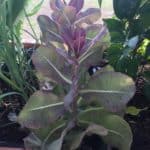Many of us live in areas that have had a lot of recent construction or current construction that is damaging to the environment and natural habitat. We recognize the animals that are displaced, but what about the beneficial insects like bees, butterflies and other pollinators?
Pollinators are vital to a vegetable garden. Some vegetables are self-pollinating, but others depend on a pollinator in order to produce the vegetables. Most tomatoes, peppers and eggplants are self-pollinating. This means that they have both male and female parts inside the same flower, so all it takes is a gust of wind and the pollen drops from the male part onto the female part.
Then, other vegetable plants like cucumbers, squash and zucchini have separate male and female flowers. The male flower is recognized by the long, thin stem. The female flower has a small bulge at the base of the flower. This bulge is what will grow into the actual vegetable once the flower has been pollinated. If it is not pollinated, the flower will shrivel up and die. The job of the butterfly or bee as they are just floating and buzzing around is to oh-so-naturally remove the pollen from the male flower and distribute it to the female. Then, two to four weeks later, you will enjoy the delicious and nutritious vegetable, right from your own backyard. Mother nature is truly amazing!

In areas where there are few or no pollinators for the garden, it is also possible to manually pollinate most vegetable plants, if the bees and butterflies are not around. There are several methods, but the most common is to use a paintbrush or Q-tip and collect the pollen yourself from the male flower and place it into the female flower. This method can be extremely effective and preserves the flower so it can stay around and continue to provide pollen. If there are an abundance of flowers, like on a cucumber plant, the actual male flower can be removed and used to pollinate the female flower.
A pollinator is not only a bee or butterfly but any insect that carries the pollen from a male flower to a female flower. In order to create your own backyard sanctuary for the pollinators, there are just a few simple things that you need to know.
First, pick the right location. Ensure that the location gets at least four to six hours of direct sunlight for flowers to thrive. Make sure there is a reliable water source as well.
Then, pick the right flowers and plants. Plant several of the flowers together to offer a clear source of pollen or nectar. Some examples are milkweed, wild geraniums, sunflowers, and black-eyed susans. Beneficial insects also need a nesting site so have clumping grass planted like lemongrass or muhly grass to provide a good home for them to nest.

There are particular types of flowers that can attract different pollinators. For example, bees are also attracted to specific colors of flowers like white, yellow, blue and purple. Also, milkweed is a favorite of the monarch butterfly. It is important to remember not only to plant flowers that attract pollinators but to plant a nectar source, too.
Finally, maintain a healthy yard environment. Minimize the use of pesticides and chemical treatments in the yard. These all disrupt the natural ecosystem and can directly or indirectly kill the pollinators.
As we enjoy the beautiful surroundings here in Lake Nona, let’s be sure to give back to nature and be a host for these amazing insects that play a vital role in our ecosystem and our gardens.
Amber Harmon is the Owner of My Nona’s Garden, where we sell and service low-maintenance, elevated, organic vegetable gardens. Our mission is to bring health, promote growth and provide vegetable gardening education to local communities, one garden at a time. Visit www.MyNonasGarden.com for more information.
“We make organic vegetable gardening Easy!”



